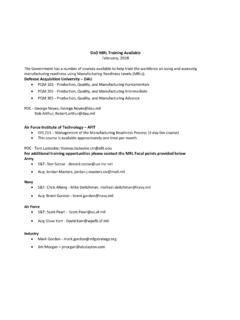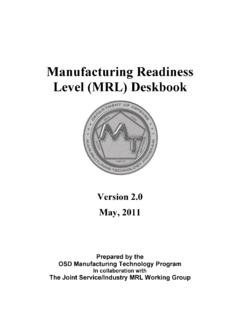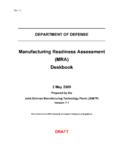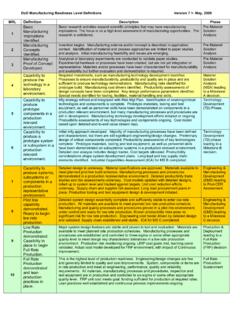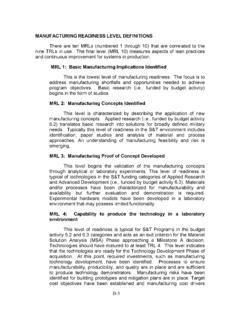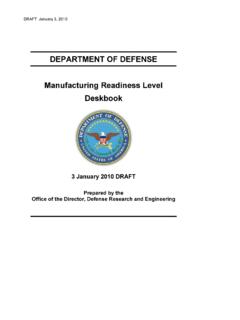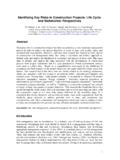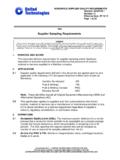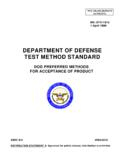Transcription of DATA ITEM DESCRIPTION - dodmrl.com
1 data ITEM DESCRIPTION Title: MANUFACTURING PLAN Number: DI-MGMT-81889 Approval Date: 20130118 AMSC Number: N9311 Limitation: N/A DTIC Applicable: N/A GIDEP Applicable: N/A Office of Primary Responsibility: AS/AIR Applicable Forms: N/A Use/relationship: The Manufacturing Plan identifies the contractor s overall system and detailed factors necessary to achieve an effective and efficient manufacturing program. This data Item DESCRIPTION (DID) is applied in the RFP and contract for all phases of system acquisition. Sections applicable to the acquisition will be identified by the buying activity by tailoring this DID in the CDRL. This DID contains the format, content and intended use information for the data deliverable resulting from work task requirements delineated in the contract. Requirements: 1. Format. Contractor s format is acceptable.
2 2. Content. The manufacturing plan is the compilation of those documents the contractor uses to plan and manage their manufacturing effort. data may be presented in the format used in the contractor's system, if all the required information is presented logically. Updates required by contract will be as specified below. data shall be organized into sections comprised of paragraphs as designated as stated below. The first page in each section or sub section shall be a DESCRIPTION of the material in that section. A section may refer to material in other sections containing some or all the required data in fully useable form. The manufacturing Plan shall include the following: a. Introduction - This section includes general implementing instructions for the program, such as program manager assignment letter or other document defining responsibility for the manufacturing management of the program.
3 I. Background - This section contains material descriptive of other programs in-house for programs having a scope of production effort valued at 20 percent or more of the value of the program represented by the plan. Information shall include contract price for each program phase, product type, brief DESCRIPTION , customer(s), milestone schedule, location, names, and telephone numbers of recommended points of contact for specific areas of responsibility. ii. Manufacturing organization - This section contains organization charts showing the flow of authority and responsibility for performance of the manufacturing management tasks required by contract from the highest corporate officer to line supervision. The contractor may designate the DI-MGMT-81889 Page 2 of 6 names and telephone numbers of recommended points of contact for specific areas of responsibility.
4 Iii. Manufacturing management system This section should describe the process by which the contractor establishes and maintains a flexible process to identify, order materials and parts, structure orders for parts and components internally and generally launch and track a project to produce the end items on the contract. b. Manufacturing management program - The contractor documents defining the manufacturing strategy and consolidating relevant manufacturing management information into a planning structure shall be included. i. Program manufacturing time -phased schedule - time -phased schedules in this section are those contractor documents that logically portray how all events in the manufacturing process occur in time to assure contract requirements are met. Included on these schedules are events in: 1. Development, design, redesign, and test efforts for system elements.
5 2. Special tooling, special test equipment and test support equipment design, fabrication and delivery. 3. Development and testing of software necessary for manufacturing or testing. 4. Government-furnished property need dates. 5. Subcontractor deliveries. 6. Major elements of the manufacturing process. 7. Critical/Strategic Material deliveries. 8. Milestone chart of delivery schedule. ii. Manpower plan This section contains documents used to plan the workforce for the program. Information required is number of individuals required by skill for each month of and production, and data used to verify that the individuals will be available when required by this plan. Planning and schedules for training will be included. Updates may provide new information only, or total document update, as used in the contractor's management system. iii. Industrial facilities capacity assessment - This section shall include data used to verify that manufacturing facility needs of the program will not be impacted by the needs of existing or projected programs.
6 data shall include time -phased manufacturing schedules for those other programs, assignment of floor space, machines, or other units of resources to programs, and other data used by the contractor to verify that he will meet contract schedule requirements. Updates to this assessment will address impact of actual or planned changes to facilities use. iv. Surge and Mobilization Capacity Assessment - The assessment prepared during review of capability to meet surge and mobilization needs will be provided in contractor format, presenting ground rules, plan for meeting requirements, shortfalls, possible action to eliminate shortfalls, and maximum rate with available manufacturing resources. DI-MGMT-81889 Page 3 of 6 v. Manufacturing Risk Assessment - This section includes summary sheets, matrices or other document prepared during assessment of manufacturing risk in accordance with the NAVAIR risk process.
7 Material provided shall address all issues related to the manufacturing process. Updates to this assessment will assess impact of significant schedule change (acceleration or deceleration), design change or change in the manufacturing environment. vi. Capital Investment Commitment - This section comprises a contractor commitment indicating the minimum annual rate at which capital will be committed to correct shortfalls indicated by manufacturing planning efforts including those listed above. The specific investment to be applied to each shortfall, and how the investment will improve production will be described in this section. c. Manufacturing Programs Planning i. Producibility Program Plan - Contractor producibility program planning documents will be included in this section. They will include procedure for performing producibility analyses, identification of groups responsible for analysis, listing of studies to be performed, listing of potential additional study subjects, a milestone chart of planned activities, and checklist of producibility criteria.
8 Updates shall include current revisions to all documents provided. ii. Make-or-Buy Criteria - Manufacturing considerations reviewed during make-or-buy will be included in this section. They include: 1. Conservation of critical and strategic materials 2. Reduction of critical forms and parts (reduced foreign dependence) 3. Capacity to support normal production needs, surge, and mobilization 4. Risk reduction 5. Second-sourcing of critical components, including Critical Safety Items 6. Standardization of components and parts iii. Subcontractor/ supplier Management - The list of proposed major/critical subcontractors and suppliers, including those associated with Critical Safety Items, developed for contractor subcontractor/ supplier management including locations at which suppliers plan to manufacture items or components are presented here. The data and summary used to determine subcontractor capacity and capability to meet schedule requirements, to support decisions relative to second sourcing and to define manufacturing risk are provided.
9 A one page summary of the system used to track supplier progress, showing how supplier potential delivery problems are detected and corrected prefaces this section. When work is performed by other parts of the corporate entity of which the contractor is a part, the contractor's subsidiaries or affiliates, organization charts that describe the relationship between the performing entity and the contractor are presented here. Updates shall include lists originated by the contractor's supplier management system of delinquent and projected DI-MGMT-81889 Page 4 of 6 delinquent suppliers, and supplier management summaries used within the contractor's management system, and a counterfeit prevention plan. iv. Manufacturing Methods and Production Flow - The planning documentation used to plan manufacturing methods and production flow are presented here. The documents shall: 1.
10 Identify any advanced or unique manufacturing technology required to produce components or end item(s). Include tools and processes which require proofing or demonstration to minimize high risk or critical operations. 2. Show a production flow utilizing a goes-into chart, tree chart, or equivalent, to portray the planned process of fabrication and assembly in terms of key operational points. Show their cumulative and individual lead times from procurement of raw material to delivery of end items. Show supporting documentation starting with the purchase of raw material, through delivery of the contract end items. Show supporting material used to determine the validity of the proposed flow times. 3. Identify those production, test, or inspection stations which have bottleneck potential due to space, manpower, tooling, test equipment or machine utilization rate limitations and identify corrective action.
